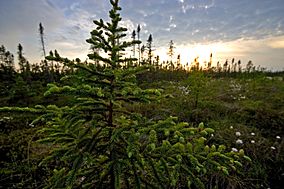Big Bog State Recreation Area facts for kids
Quick facts for kids Big Bog State Recreation Area |
|
|---|---|

Big Bog State Recreation Area
|
|
| Location | Beltrami, Minnesota, United States |
| Area | 9,459 acres (38.28 km2) |
| Established | 2006 |
| Governing body | Minnesota Department of Natural Resources |
Big Bog State Recreation Area is a special park in Minnesota, United States. It's located in the northern part of the state, near a town called Waskish. This huge area is about 9,459 acres, which is like 7,000 football fields! Most of it is made up of wet, marshy lands called bogs and swamps, with some drier "islands" of land.
Local people worked hard to create this park starting in 2002. It officially opened in June 2006. The name "Big Bog" describes the area well because it's mostly wetlands. This large bog region stretches across several counties in northern Minnesota. It includes parts of the Pine Island State Forest and two important natural areas. The Big Bog is mostly wild and unpopulated.
Contents
What Plants and Animals Live Here?
The Big Bog is home to many different plants and animals.
Trees and Plants
You can find many types of trees in the bog. Some common ones are:
On the drier "islands" within the bog, you might see:
- Paper birch
- Quaking aspen (sometimes called "popple")
- White pine
- Red pine
The bog also has some very rare plants. These include carnivorous plants like sundews and pitcher plants. These plants are special because they eat insects!
Animals
Many animals live in the Big Bog. Keep an eye out for:
A Look Back: The Bog's History
The Big Bog sits on land that was once the bottom of a giant glacial lake called Lake Agassiz. This lake formed during the last ice age. When the lake drained, the flat land slowly filled with wetland plants and animals.
For a long time, the Anishinaabe people lived here. They gathered blueberries, fished, and hunted in the bog until the late 1800s. In the 1920s and 1930s, many old pine trees in nearby areas were cut down for logging. However, the Big Bog was mostly left untouched because it was too swampy for large logging operations.
Some people tried to drain parts of the bog or harvest its peat (decayed plant material), but these efforts were not very successful. In the 1930s and 1940s, some small farming communities in remote areas were moved as part of rural improvements.
In the 1990s, the number of walleye fish in the nearby Red Lakes dropped. This was tough for the local community, which depended on fishing. In 2002, people from the Upper Red Lake Area Association suggested creating a new state park. Soon after, nearly 10,000 acres became the Big Bog State Recreation Area.
Exploring the Bog: The Boardwalk
One of the best ways to explore the Big Bog is by walking on its special boardwalk. This raised walkway goes about one mile (1.6 km) into the bog. It lets visitors see the "islands" of spruce trees and the open wetlands up close.
The boardwalk was designed so that sunlight can still reach the delicate plants growing underneath it. Along the way, signs help you learn about the bog's features. You can see pitcher plants and learn about an old attempt to drain the swamp. Remember to buy a parking pass at the nature center, which is about nine miles south of the boardwalk, near Waskish.
Special Natural Areas
The larger Big Bog area includes two very important natural places:
Upper Red Lake Peatland
This area is a National Natural Landmark. It was given this special title in 1975 by the United States Secretary of the Interior. This means it's recognized as an amazing example of the nation's natural history. It's described as one of the largest peatlands in the United States. It shows many different geological features and plant groups, especially a rare type of bog called a "string bog." It's also a great home for wildlife, including endangered species.
Lost River Peatland
The Lost River Peatland is another important part of the greater Big Bog area. It's a designated Scientific and Natural Area for the state of Minnesota since 1991. It's also an Important Bird Area recognized by Audubon. This peatland has the largest number of rare plant species of any peatland in Minnesota.




